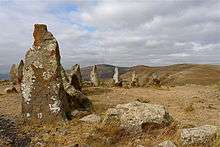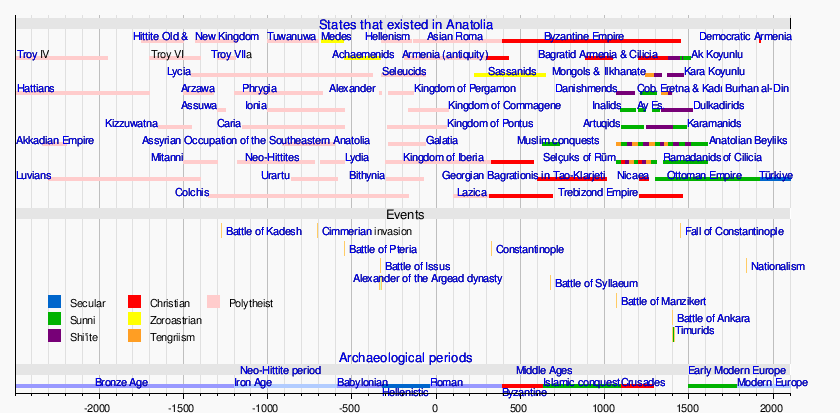Prehistoric Armenia
The modern territory of Armenia has been settled by human groups from the Lower Paleolithic to modern days. The first human traces are supported by the presence of Acheulean tools, generally close to the obsidian outcrops more than 1 million years ago.[1] Middle and Upper Paleolithic settlements have also been identified such as at the Hovk 1 cave and the Trialetian culture.[2] The Armenian Highland finally shows traces of settlement from the Neolithic era. The Shulaveri-Shomu culture of the central Transcaucasus region is one of the earliest known prehistoric cultures in the area, carbon-dated to roughly 6000 - 4000 BC. The Shulaveri-Shomu culture in the area was succeeded by the Bronze Age Kura-Araxes culture, dated to the period of ca. 3400 - 2000 BC. The Kura-Araxes culture was then later succeeded by the Trialeti culture (ca. 2200 - 1500 BC).
Paleolithic
The most recent and important excavation is at the Nor Geghi 1 Stone Age site in the Hrazdan river valley.[3] Thousands of 325,000 year-old artifacts show that human technological innovation occurred intermittently throughout the Old World, rather than spreading from a single point of origin (usually hypothesized to be Africa), as was previously thought.[4]
Neolithic
In the Ararat plain, the sites of Aknashen and Aratashen are known to belong to the Neolithic period.[5] The Mestamor archaeological site, located to the southwest of Armenian village of Taronik in the Armavir Province, also shows evidence of settlement starting from the Neolithic era.
Bronze Age

An early Bronze-Age culture in the area is the Kura-Araxes culture, assigned to the period between c. 4000 and 2200 BC. The earliest evidence for this culture is found on the Ararat plain; thence it spread to Georgia by 3000 BC (but never reaching Colchis), proceeding westward and to the south-east into an area below the Urmia basin and Lake Van. Early 20th-century scholars suggested that the name Armenian may have possibly been recorded for the first time on an inscription which mentions Armanî (or Armânum) together with Ibla, from territories conquered by Naram-Sin (2300 BC) identified with an Akkadian colony in the current region of Diyarbekir; however, the precise locations of both Armani and Ibla are unclear. Today, the Modern Assyrians (who traditionally speak Neo-Aramaic, however, not Akkadian) refer to the Armenians by the name Armani.[6] The word is also speculated to be related to the Mannaeans, which may be identical to the biblical Minni.
The earliest forms of the word Hayastan, an ethonym the Armenians (Hayer) use to designate their country, might possibly come from Hittite sources of the Late Bronze Age, such as the kingdom of Hayasa-Azzi. Another record mentioned by pharaoh Thutmose III of Egypt in the 33rd year of his reign (1446 BC) as the people of Ermenen, and says in their land "heaven rests upon its four pillars".[7] However, what all these attestations refer to cannot be determined with certainty, and the earliest certain attestation of the name Armenia comes from the Behistun Inscription (c. 500 BC).
Between 1500 and 1200 BC, the Hayasa-Azzi existed in the western half of the Armenian Highland, often clashing with the Hittite Empire. Between 1200 and 800 BC, much of Armenia was united under a confederation of kingdoms, which Assyrian sources called Nairi ("Land of Rivers" in Assyrian").
Iron Age
The main object of early Assyrian incursions into Armenia was to obtain metals. The iron-working age followed that of bronze everywhere, opening a new epoch of human progress. Its influence is noticeable in Armenia, and the transition period is well marked. Tombs whose metal contents are all of bronze are of an older epoch. In most of the cemeteries explored, both bronze and iron furniture were found, indicating the gradual advance into the Iron Age.
See also
References
- ↑ Dolukhanov, Pavel; Aslanian, Stepan; Kolpakov, Evgeny; Belyaeva, Elena (2004). "Prehistoric Sites in Northern Armenia". Antiquity. 78 (301).
- ↑ Pinhasi, R.; Gasparian, B.; Wilkinson, K.; Bailey, R.; Bar-Oz, G.; Bruch, A.; Chataigner, C. (2008). "Hovk 1 and the Middle and Upper Paleolithic of Armenia: a preliminary framework". Journal of Human Evolution. 55 (5): 803–816. doi:10.1016/j.jhevol.2008.04.005. PMID 18930308.
- ↑ Adler, D. S.; Wilkinson, K. N.; Blockley, S.; Mark, D. F.; Pinhasi, R.; Schmidt-Magee, B. A.; Nahapetyan, S.; Mallol, C.; Berna, F. (2014-09-26). "Early Levallois technology and the Lower to Middle Paleolithic transition in the Southern Caucasus". Science. 345 (6204): 1609–1613. doi:10.1126/science.1256484. ISSN 0036-8075. PMID 25258079.
- ↑ 325,000 Year Old Stone Age Site In Armenia Leads To Human Technology Rethink
- ↑ The earliest finds of cultivated plants in Armenia: evidencefrom charred remains and crop processing residues in pise´from the Neolithic settlements of Aratashen and Aknashen, Roman Hovsepyan, George Wilcox, 2008
- ↑ Martiros Kavoukjian, "The Genesis of Armenian People", Montreal, 1982.
- ↑ International Standard Bible Encyclopedia, 1915 ; Eric H. Cline and David O'Connor (eds.) Thutmose III, University of Michigan, 2006; ISBN 978-0-472-11467-2.
- ↑ "Armenians" in Encyclopedia of Indo-European Culture or EIEC, edited by J. P. Mallory and Douglas Q. Adams, published in 1997 by Fitzroy Dearborn.


